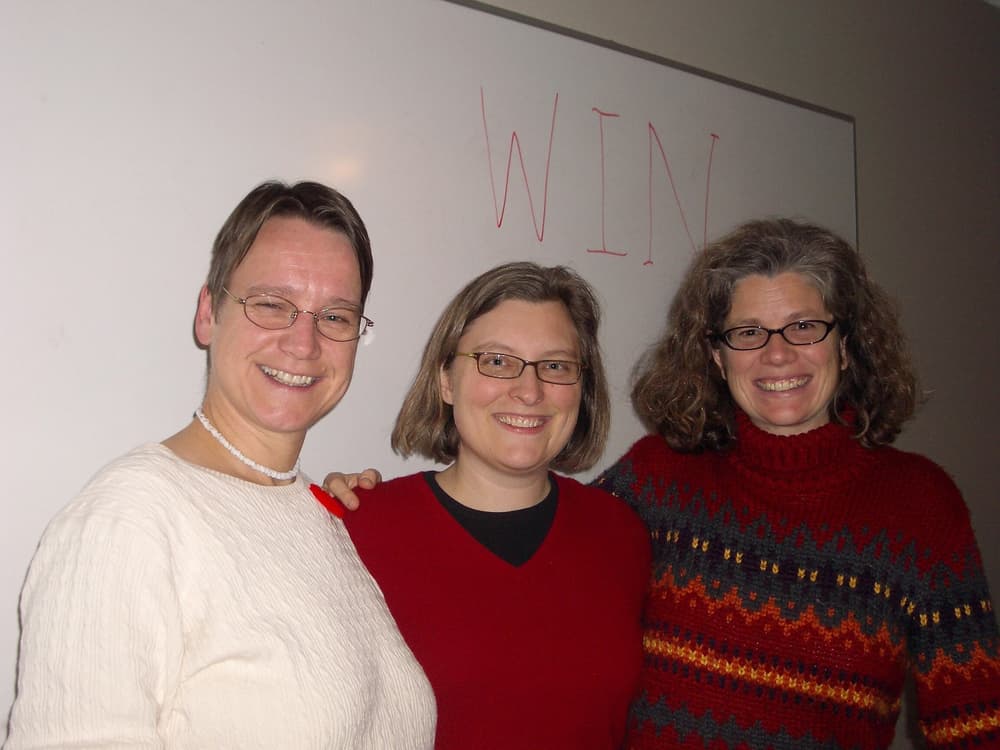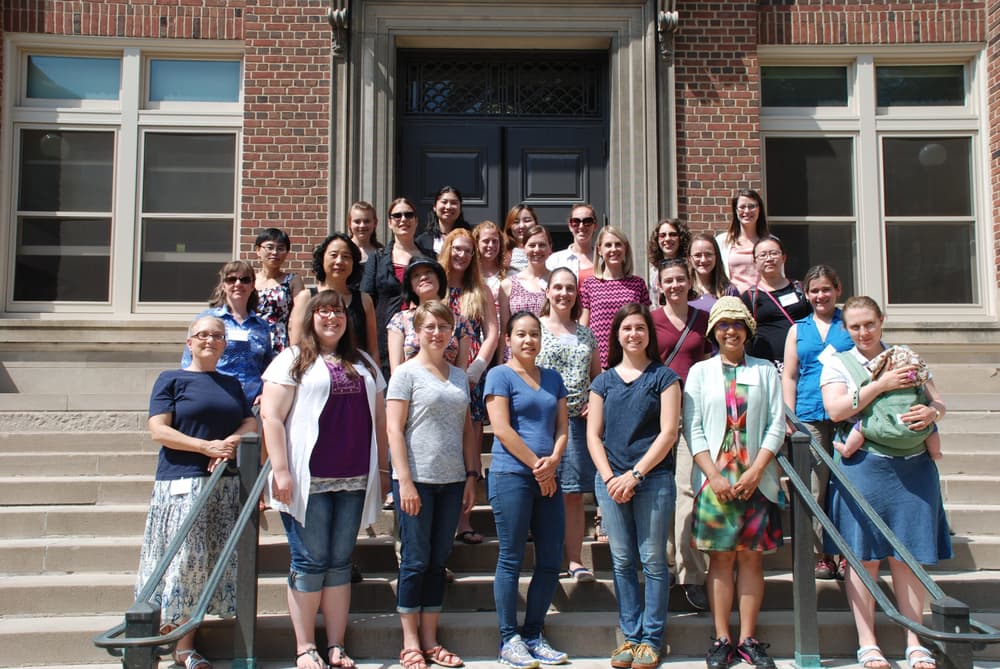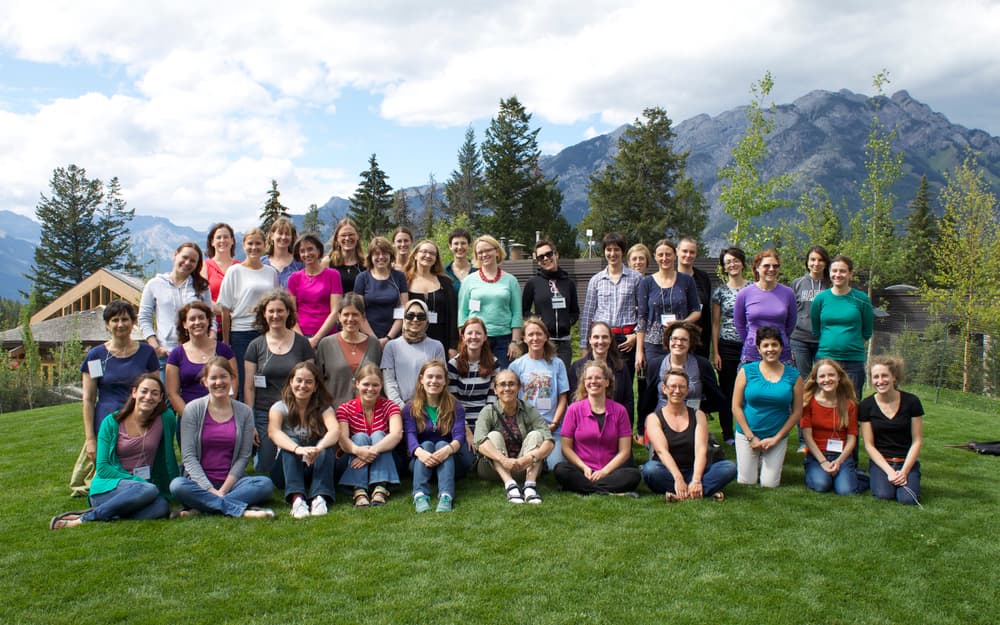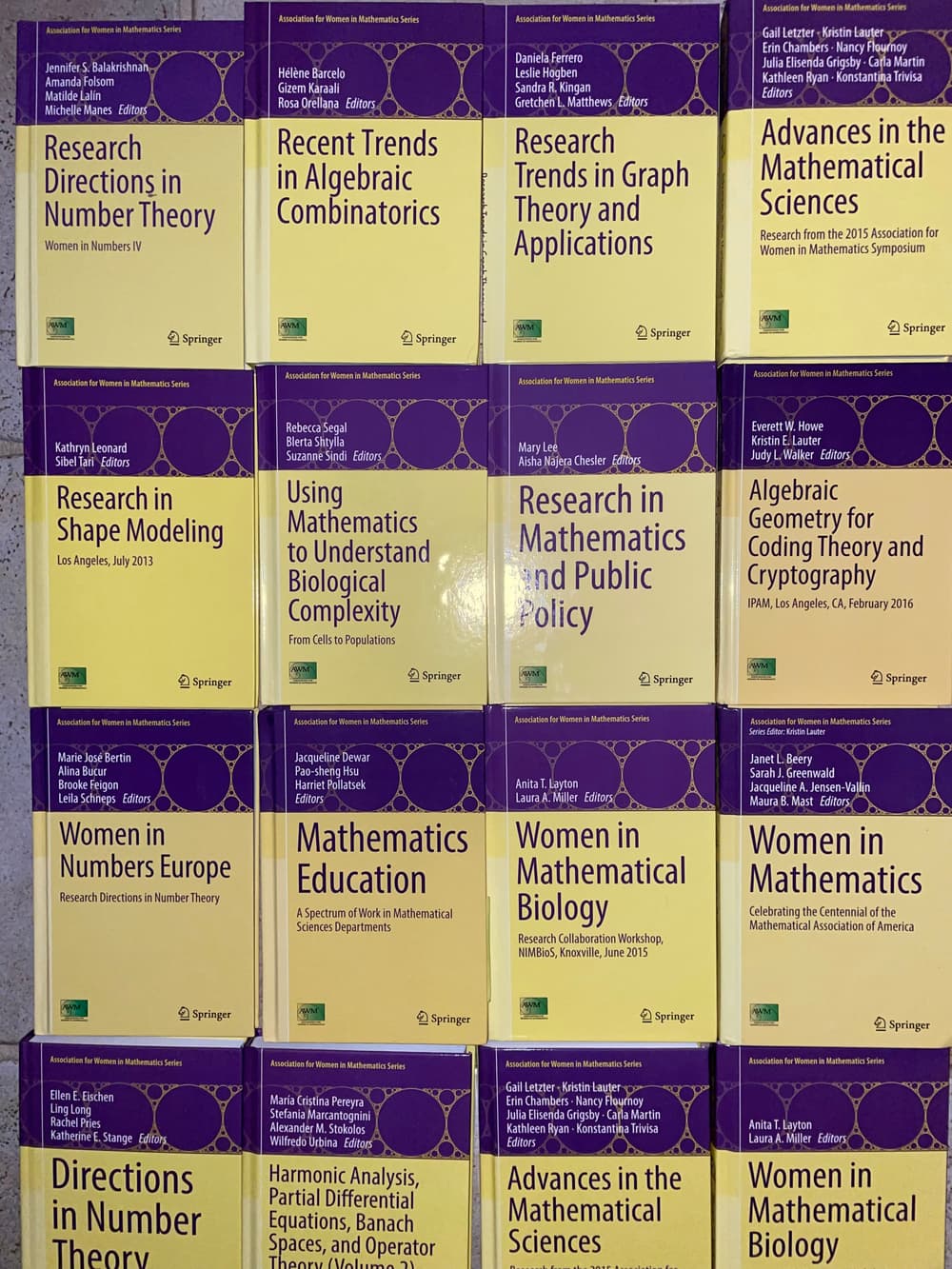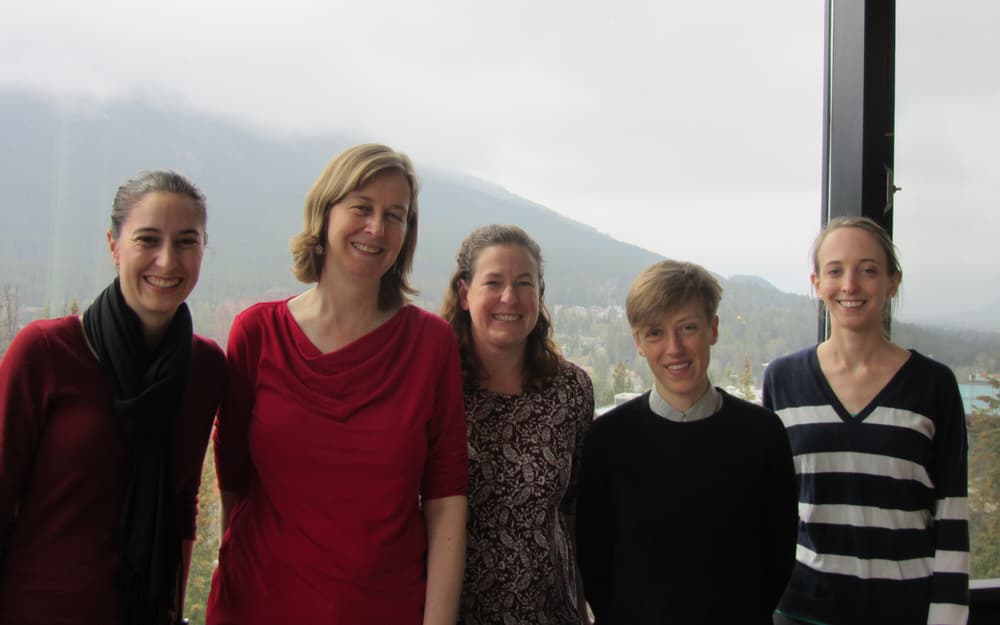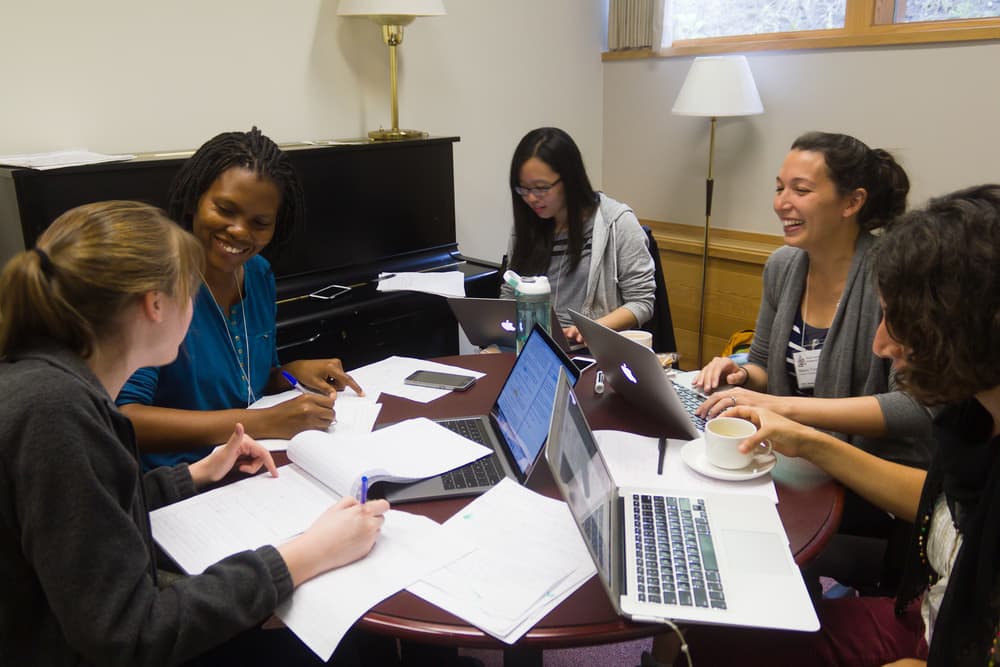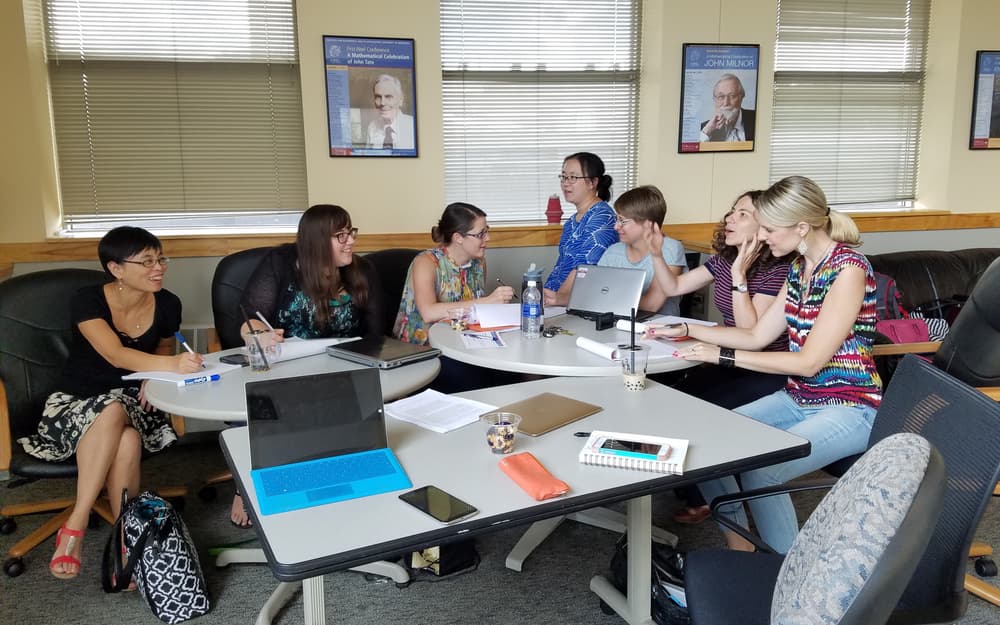1 Introduction
The gender gap is well studied in mathematics, and is particularly drastic in senior academic and research-focused positions. For example, a recent analysis of the percentage of publishing authors in mathematics journals shows that only about 27 % of authors are women; this drops to under 10 % when considering the most highly ranked journals.1https://gendergapinscience.files.wordpress.com/2020/07/gendergapinscience_diapos.pdf Similarly, when considering editorial boards of math journals, women comprise only 8.9 % of all such positions [5 C. M. Topaz and S. Sen, Gender representation on journal editorial boards in the mathematical sciences. PLOS ONE 11, e0161357 (2016) ]. While the exact percentage of women in faculty positions varies across countries, it seems clear there is a persistent problem. As a result, many initiatives have been set up to increase recruitment and retention, generally by enforcing quotas or attempting to reduce bias in the review process for grants or publications [6 Implicit bias in academia: A challenge to the meritocratic principle and to women’s careers – and what to do about it. www.leru.org/publications/implicit-bias-in-academia-a-challenge-to-the-meritocratic-principle-and-to-womens-careers-and-what-to-do-about-it (2018) ].
This article describes a recent initiative from the Association of Women in Mathematics, which instead proposes focused research collaboration workshops for women. Instead of events for women which only focus on networking and work-life balance panels, these events bring research to the forefront. The philosophy of the Research Networks program is to promote the creation of new communities of women supporting each other in research to change the ecosystem. Our model for making change is based on the observation that the math research community itself is a network with its own hierarchical structure. To integrate with that, we have created Research Networks for women in a scalable way which can help advance women’s careers and then connect back to the existing hierarchical structure where women are minoritized and have less power.
Several key elements of the structure that enable success:
Women help each other in research through vertical integration – senior women mentoring junior women on research problems and in their careers.
Groups of women collaborators help to promote their joint work in the broader community through giving research talks and co-organizing conferences with many women speakers.
Junior women are empowered to co-organize conferences with men and invite their women colleagues, and to participate in the editorial and reviewing process at an earlier career stage.
Junior and senior women participate in program committees to actively promote the inclusion of women speakers in major conferences and on editorial boards.
While Research Networks for Women represent a drastic change from the standard goal of making all workshops more diverse (which generally means about 20 % women participants), we propose it as an effective way to build community for minoritized groups and to bootstrap progress on the larger diversity goal. Of course, not all approaches work equally well for all groups, but it is worth considering such efforts on a broader scale, with possible modification, if they are successful with one group. Preliminary data on these Research Networks shows that they are extremely effective, as the number of women in top research universities in these research areas has drastically increased and overall visibility of women in research areas linked to networks has expanded. Indeed, many women cite their experiences with these workshops as a reason they have persisted and felt supported in their careers.
2 History
The Research Networks for Women idea started with a conversation between Kristin Lauter, Rachel Pries, and Renate Scheidler at a number theory conference in 2006. Noting the lack of women invited speakers at number theory conferences worldwide, they decided to organize a research conference for women in number theory. To build community and to support graduate students entering the “leaky pipeline”, they decided to design it as a collaboration conference, a Research Collaboration Conference for Women (RCCW), with group leaders proposing research problems ahead of time, and open to students and junior researchers to apply to participate. Former Fields Institute director Barbara Keyfitz supported the idea and suggested applying to Banff International Research Station (BIRS) through the usual scientific process, which succeeded. The first Women In Numbers (WIN) conference was hosted by BIRS in 2008, and a volume of research papers written by the groups was published in the Fields Institute Series [3 A.-C. Cojocaru, K. Lauter, R. Pries and R. Scheidler, WIN – Women in numbers – Research directions in number theory. Fields Inst. Commun. 60, American Mathematical Society, Providence (2011) ].
BIRS is a conference center in the Canadian Rocky Mountains which runs 50 week-long conferences per year, where 42 mathematicians are invited to spend five days presenting and listening to math research talks. Historically more than 90 percent of the participants were men. The WIN model was different because the participants were all women, students were encouraged to apply, research problems and groups were proposed and decided in advance, and almost all of the conference time was devoted to group work on the research problems. The WIN groups continued to work together after the conference to finish their results for publication in the volume.
During and after the 2008 WIN conference, the organizers and many of the participants worked together to form the WIN network: a research community for Women in Number Theory. Michelle Manes created an email distribution list and organized follow-up special sessions at AMS meetings; Katherine Stange created a website2https://womeninnumbertheory.org/ highlighting women in number theory; the WIN organizers created a Steering Committee to plan future meetings and selected new organizers for the next conference at each successive WIN conference.
Since then, the WIN Network has run seven more conferences on this model, four at BIRS and three in Europe to broaden participation. These conferences involved more than 200 women in number theory from around the world, were organized by more than 20 different women, many of them participants in the first WIN conference, and produced more than 50 published research papers in eight proceedings volumes. When planning started for the first WIN conference in 2006, there were three women professors in number theory at top research universities in the US; now there are several dozen women faculty in number theory, most of whom participated in WIN. The success of the WIN collaboration model was palpable from the very first conference: the BIRS staff said they had never experienced such energy and excitement from workshop participants, although they had been running week-long workshops 50 weeks per year for many years.
Early adopters pushed the WIN model into other areas of mathematics. Maria Basterra, Kristine Bauer, Kathryn Hess, and Brenda Johnson launched WIT: Women in Topology at BIRS (WIT workshops were held in 2013, 2016, 2019). Kathryn Leonard and Luminita Vese launched the Women in Shape Modeling (WiSh) network at IPAM in 2013, securing funding from private sources and companies to launch it (WiSh workshops were held in 2013, 2015, 2017, and 2021). In 2012, Kristin Lauter collaborated with the then director of the Institute for Mathematics and its Applications (IMA), Fadil Santosa, to plan and fund one conference on the WIN model per year, for three years. The result was three RCCWs hosted by the IMA: WhAM! Women in Applied Math, Dynamical Systems in Biology (2013), WINASC: Women in Numerical Analysis and Scientific Computing (2014), and WinCompTop: Women in Computational Topology (2016).
Based on the preliminary success of the WIN model in number theory and these other areas, AWM received a 5-year National Science Foundation Advance grant (2015–2020) to spread the model to all areas of mathematics (grant oversight committee: AWM Presidents Ruth Charney, Kristin Lauter, and Kathryn Leonard, and AWM executive director Magnhild Lien). The goal of the program, “Career Advancement for Women through Research-focused Networks”, was to build and sustain Research Networks for women in many areas of mathematics. The program has supported more than 2,000 women researchers in 25 Research Networks so far, with more new networks in formation. In addition to BIRS, RCCWs are being hosted annually by Institute for Computational and Experimental Research in Mathematics (ICERM), Institute for Pure and Applied Mathematics (IPAM), IMA, and American Institute of Mathematics (AIM). Several Research Networks have run conferences at institutes in Europe, including Luminy (CIRM), Lorentz Center, Nesin Village, Henri Lebesgue Institute, Hausdorff Center for Mathematics (HCM), University of Leeds, and Universität Trier.
To support the Research Networks, AWM runs follow-up workshops at the annual JMM and SIAM meetings. Each workshop showcases the work of one of the RNs, and serves to reunite the participants to continue collaboration and mentoring. A significant portion of the funds from the AWM ADVANCE grant were devoted to participant expenses to speak at these annual workshops and at the special sessions for Research Networks at the biennial AWM Research Symposia.
The AWM Research Symposia started with the AWM 40th anniversary celebration at Brown University and ICERM in 2011, co-organized by Georgia Benkart, Kristin Lauter, and Jill Pipher when Jill was president of AWM and founding director of ICERM. The Symposia are two-day weekend meetings, run on the model of the AMS sectional conferences, with high-profile Plenary Speakers and Special Sessions organized by the Research Networks. The Symposia aim to bring women mathematicians together to recognize and celebrate their research contributions and achievements, and to network and build community in order to advance their careers and improve working conditions. Professional development activities include a non-academic jobs panel, an exhibit hall, and networking opportunities. The Symposia were held every two years until 2021, when it was was delayed to 2022.
More information about the Research Networks program is available on the AWM website3https://awm-math.org/programs/advance-research-communities/research-networks/, which hosts webpages and email listservs for each Research Network and provides a framework and global information about the program.
3 RCCW and RN Committees
It is important to emphasize that a research network is grown by a group of women in that research area, so these are not external efforts. AWM’s role in this has been to encourage groups to form, by pointing out opportunities and providing logistical support and advice. Currently, AWM has two committees that help in the formation and growth of the Research Networks. The first is the Research Collaboration Conferences for Women Committee (RCCW Committee), chaired for the first three years by Michelle Manes and now by Erin Chambers. The goal of this committee is to help research networks form in new areas by accepting proposals twice a year. The chair assigns each proposal to a committee member, who helps edit and match with one of the math institutes to submit through their competitive processes. The second is the Research Network Committee (RN Committee), which was chaired initially by Sigal Gottlieb, then Kathryn Leonard, and now by Kristin Lauter. This committee helps existing Research Networks grow and continue after the initial workshop.
Both committees advise the Research Networks to form some structure to ensure continuity. In particular, networks are encouraged to consider the following actions:
form their own Steering Committee;
appoint a web administrator to create and maintain a webpage;
create a listserv to facilitate communication;
organize follow-up events such as Special Sessions and AWM Workshops;
publish a Proceedings volume in the AWM-Springer Series;
publish accounts of their networks in the AWM Newsletter.
In addition, the RCCW and RN Committees have helped to balance the number of submissions for RCCWs at any given math institute, as well as to brainstorm new venues to be considered. The RN Committee has developed a set of materials to help new networks decide on structures and processes, which they call “How to Launch a Research Network”.4https://awm-math.org/wp-content/uploads/2020/11/AwmAdvance_howtorn038.pdf Both committees have helped the networks strategize on how to organize a workshop that best fits their area, and continue to discuss the benefits of the workshops in terms of growing a stronger community of active women researchers.
Institute for Mathematics and its Applications, 2016. All rights reserved.
4 Launching a Research Network – an example
If you’ve read this far, you may be starting to wonder “how can I start a research network for women in my community?” In addition to making use of the guidance provided by the AWM through its document “How to Launch a Research Network” and many services to support networks, it can be instructive to consider specific examples as well. In what follows, we describe the formation of the Women in Topology network.
New networks often start with a small group of individuals looking to make a change in the makeup or culture of their research community. For Women in Numbers, that group of individuals, Kristin Lauter, Rachel Pries, and Renate Scheidler, were concerned about the dearth of invited women speakers at conferences. Women in Topology started with a conversation between Maria Basterra, Kristine Bauer, Kathryn Hess, and Brenda Johnson at a BIRS workshop in 2011. By that time, the first WIN workshop had taken place and planning for the second one was underway. Kristine Bauer had heard about WIN from her colleague Renate Scheidler and was wondering if such a program would serve to address issues in the field of algebraic topology, especially the lack of senior women in the field at research universities, and a leaky pipeline in the transition from graduate student to permanent academic position. These conversations were taking place when a particularly strong cohort of women researchers was completing PhDs and starting postdoctoral positions in algebraic topology. After initial conversations at the BIRS workshop and the AWM’s first research symposium the following fall, a proposal was submitted for a workshop at BIRS, using the WIN collaborative research conferences as a model. The proposal was accepted, and planning began in earnest for the first WIT workshop in 2013.
When forming a new Research Network for women, especially in a field in which women have traditionally been underrepresented, it can be a challenge to find a critical mass of participants. For a collaborative research conference, one needs to find both team leaders and team members.
Given that the field of algebraic topology had few senior women at research universities in 2012, recruiting team leaders involved recruiting more junior faculty members, some of whom had little or no experience in directing research projects, or were just entering tenure-track positions. For these leaders, the experiment of participating in WIT carried some risks and required rapid development of certain skills. A benefit of this approach was to provide training and experience for future PhD advisors, and to expose participants to leaders from a wide range of institutions. Team members were recruited by first contacting PhD advisors in the field to solicit recommendations, and then sending out invitations to recommended individuals. This process also served to inform leaders in the community about the WIT workshop and enlist their support. One sign of success for the WIT network is that the number of women in the field has grown to the point that leaders and participants now must apply for the limited number of spots available in collaborative research conferences, and the network has explored other models for meaningful research events to involve more participants.
The organizers of the first WIT workshop chose to publish a proceedings volume and encouraged all teams to submit a paper for the volume. Although this put more pressure on team leaders, it also helped to focus teams on completing concrete projects, and served a number of other purposes, which we address in the next section. The proceedings for the first workshop were published in the American Mathematical Society’s Contemporary Mathematics series [1 M. Basterra, K. Bauer, K. Hess and B. Johnson, Women in topology: collaborations in homotopy theory. Contemp. Math. 641, American Mathematical Society, Providence (2015) ].
Going into the first workshop, no one knew what to expect. But testimonials posted after the workshop on the BIRS website enthusiastically describe the intensely productive and cooperative atmosphere that prevailed:5www.birs.ca/events/2013/5-day-workshops/13w5145/testimonials
This was the most productive workshop I’ve attended in my career. We went from a few half-baked ideas to enough material for a research paper over the span of four (albeit rather long) days. I now have new collaborators with whom I’m eager to work in the future. I expect this week to pay dividends for a long time.
I have no hesitation to say that the WIT workshop was the best and most successful and productive mathematical event that I have ever attended, and here is why: – One of the workshop’s goals was to forge collaborations between women in topology, and it has been accomplished. In my case (and I believe many others too), the collaboration will be continuing well beyond the scope of the workshop.
Banff International Research Station, 2013. All rights reserved.
The WIT network grew out of this first workshop. A second collaborative research conference (WIT2) was held at BIRS in 2016, again organized by Maria Basterra, Kristine Bauer, Kathryn Hess, and Brenda Johnson, with proceedings published as a special issue of Topology and its Applications [2 M. Basterra, K. Bauer, K. Hess and B. Johnson, Virtual special issue – Women in topology II: Further collaborations in homotopy theory [Editorial]. Topology Appl. 235, A1–A2 (2018) ]. This team also organized a shorter workshop at Mathematical Sciences Research Institute (MSRI) in 2017 that accommodated many more participants, highlighted the work of early career researchers, and was open to all genders, though the focus was on the work of women. The original organizers stepped down after the 2017 workshop, but continue to serve on the WIT steering committee, which is composed of current and past organizers. Subsequent activities have been planned by a number of WIT conference alumnae. A third collaborative research conference was held in 2019 at the HCM in Bonn, and planning is underway for another collaborative research conference at HCM in 2023.
5 Publication
The importance of publishing a volume of research articles based on a RCCW cannot be overstated. Setting a concrete goal together with a deadline motivates research groups to continue working together after a workshop and to complete at least one paper based on their collaboration. The AWM Springer Series was launched in 2014 to create a home for the proceedings volumes of research articles produced by the collaboration groups at the RCCWs. The Founding Editor of the series is Kristin Lauter. The series also publishes the proceedings of the AWM Research Symposia, AWM Workshops, and other AWM, events such as the 50th Anniversary volume. A list of the 30 volumes published to date is available on the series webpage6www.springer.com/series/13764. RCCWs have also published proceedings as special issues of journals and in other conference proceedings series, such as the Contemporary Mathematics series produced by the American Mathematical Society. These proceedings volumes provide a record of the research done by the groups, demonstrating the serious nature of the conferences. They also benefit the participants and RCCWs in many other significant ways.
Besides being able to add another paper to their CV, early-career participants gain valuable experience in the process of publishing and advertising research results. At early career stages, such opportunities for professional development can help women to persist in the research mathematics profession. In addition, group leaders often write recommendation letters for graduate students or postdoctoral group members based on their contributions to the paper. In cases where collaboration groups develop a longer-term research program, publishing a proceedings paper on preliminary results guarantees that everyone in the group gets credit for their contributions, before those group members who have time and interest form spin-off collaborations to develop further results. While there is an argument to be made for publishing results in journals rather than conference proceedings, the relatively short turn-around time for proceedings volumes can help to ensure that papers are appearing in time to be of use in the job search process.
The conference proceedings also benefit other participants and the RCCW movement as a whole. Many women organizers, editors, and reviewers gain valuable experience in the publication process through their work to produce these volumes. Editing the volume and reviewing the papers becomes a community-building experience, one that invites participants to join the publication process at an earlier career stage than is typical. Having artifacts such as volumes of published research papers shows the work done by women in the area and provides evidence to argue for the importance of funding subsequent conferences for women, which in turn supports further development and organization of the Research Networks. Finally, it is worth noting that for some volumes, the editors have invited contributions from women researchers who were not at the conference, so the volumes serve to highlight work by women in the research area more broadly.
6 Assessment
By many measures, the Research Network program has been a tremendous success. Funding from the NSF ADVANCE grant was allocated for an assessment team led by Erin Leahey, PhD, who surveyed RCCW and follow-on special session participants, and also performed a final impact survey to determine longer range effects of participants in the programs. During the funded period, AWM supported 46 research collaboration conferences, three research symposia, and 15 special sessions linked to AWM workshops at large meetings. Several other affiliated special sessions were held during the same time period, but they were not evaluated.
Participant surveys were hosted on SurveyMonkey and distributed with a link mailed to RCCW or special session participants shortly after the event. Response rates for all surveys exceeded 80 % and were often above 90 %. Responses to surveys were uniformly positive, with more than 90 % of respondents agreeing with the following statements about RCCWs:
The group collaboration functioned well
The project was exciting to work on
The project has promise
I expect to continue with my collaboration group
I made connections outside of our collaboration group
The workshops met or exceeded my expectations
I would recommend the conference to a friend
I would attend the conference again, either as a member or as a project leader.
Responses to the special session survey were also quite positive, with more than 90 % of participants agreeing with the following statements.
I feel more confident working on a team.
I feel more confident doing research in the mathematical sciences.
I feel more confident about my professional opportunities.
I feel more confident about my networking opportunities.
While most of this article focuses on the academic community, these workshops also affect industry, as the following comment shows:
My Ph.D. was in pure algebraic geometry and I began a career in data science right after I finished graduate school. Exiting through the academic turnstile, I found making this switch to be disorienting and even a bit demoralizing. […] Even though I was no longer a practicing algebraic geometer, my desire to work at an edge of human understanding didn’t vanish when I accepted a job at a tech company. In this age of gratuitous information exchange, I had most of what I needed for research at my fingertips except for the most essential piece – a research community! This workshop was exactly the bridge that I needed; it was the missing piece!! […] My engagement with the WiSDM group has added more focus and fervor to my data science work, even though compressed sensing doesn’t obviously impact my company. Some of the different problem spaces I was exposed to at the workshop have even given me useful frameworks for thinking about seemingly unrelated problems at my company! A postscript that touches on the “W” in WiSDM: In my entire life, this was my very first exclusively female professional experience. I have always shied away from “women in” conferences and events because I just thought it was silly. Who cares if this is a male dominated field. Let’s just all get along and move forward. We all have the same passion. Boy, did I ever learn some things about myself at WiSDM! I have never felt such a sense of ownership and responsibility in my entire life. It was super cool. While reviewing my past has caused some chagrin and frustration, going forward I am determined to own my ideas, push them forward, deliver value, and expect some credit. Thank you so much for providing me with this experience.
Women in the Science of Data and Mathematics (WiSDM), July 2017
Following the end of the ADVANCE grant funding, Leahey and her team began a final impact study, sending surveys to all participants in RCCWs during the funded period. 302 women responded. Responses to the final impact survey were also strongly positive. Almost all respondents thought that participation in their research network had helped them professionally by improving the quantity and quality of their research (73 %), raising visibility (75 %), or increasing their access to opportunities ranging from speaking invitations to job opportunities. More than 90 % of respondents agreed that participation in a research network helped grow their professional network. Moreover, comments in response to an open-ended question show the effect on the mathematical community:
I have seen many more conferences with a balanced number of women speakers.
[My area] has seen a tremendous growth in women researchers.
The number of keynotes delivered by women is notably higher than 6 years back.
There are a lot of powerful women in [my area] because of [the research network].
I have noticed a lot more [younger] women pop up in my field largely through work they do with more established women who then promote their younger collaborators.
[In my area] there are far more papers published and more talks given by female speakers.
There are still conferences with all-male speakers or program committees, but now the [research network] steering committee can point this out and direct organizers to the network for women speakers.
7 Testimonies
The Research Networks for Women are at their core a chain of grass-roots organizations which enhance both the communities who establish the networks and the broader research community. Perhaps the most profound measure of the success of these networks is the passionate way in which individual participants, with near uniformity, report the impact that participation in Research Networks has had on their own careers. Many of these testimonies come from researchers who participated at sensitive stages of their career, and were emboldened by their experience.
Amazing experience! Most of my time was with my group, and we progressed much more than we expected to. We have plans to continue the research and have discussed further projects as well. We really enjoyed each other, and I feel like I have new collaborators and mentors as I begin an Assistant Professorship – the timing couldn’t be better. Thank you for the wonderful experience.
Women in Math Biology (WIMB), June 2019
Overall, I really enjoyed this collaboration. My group worked well together and I am excited for this collaboration to continue. I am a new tenure-track faculty member at an institution with a small math department. It is especially important for me to find outside collaboration networks to help with publications for tenure and this workshop helped me to do so.
Women in Graph Theory and Applications (WIGA), August 2019
This workshop gave me an amazing opportunity, which previously (especially as a grad student) felt like an impossible dream. Being able to work with leaders in the field was incredibly uplifting and motivating. Furthermore, the programming, the schedule and atmosphere were one of a kind and reminded me of why and how much I enjoy mathematics.
Women in Symplectic and Contact Geometry and Topology (WiSCon), July 2019
… I made a lot of new connections with researchers that I expect to continue in the future, besides just future collaborations. One of my group members has told me that she would like me to come speak at her university sometime.
Women in Operator Algebras (WOA), November 2018
I am a graduate student, and this was the first workshop or conference that I felt was completely worth the time – I learned so much, made so many connections, and am excited to continue work on our project.
Women in Shape Modeling (WiSh), June 2021
WIN had a profound impact on my career. Before attending the first WIN workshop I was contemplating leaving the profession. I had started a great tenure-track job at Oregon State University two years earlier, but found that making the transition from graduate student to postdoc to tenure-track assistant professor was throwing me for a loop … the research network forged at WIN gave me the confidence to make research a crucial and nurtured part of my university experience. I often confess that I believe WIN saved my career. My WIN mentor, Dr. Ling Long, became a long-term collaborator, mentor, and friend. I worked with her on projects at WIN2 and WIN3 as well and we have coauthored seven papers. My work with WIN continued with remotely co-leading a project at WIN4 weeks after the birth of my child, and leading a (virtual) project at WIN5 that we just submitted. WIN has been a huge part of my research life and my growth as a researcher.
Holly Swisher, Professor, Oregon State University (WIN)
Many participants in research networks indicate that the benefits of belonging to a research network are not limited to advancing one’s career goals, but rather that the workshops are personally gratifying in immeasurable ways. Some of these intangible benefits include being part of a community, a feeling of self-assuredness, personal growth, and resilience. Perhaps for this reason, many researchers return to participate in workshops in their networks again and again and are now able to report on their extensive experience.
I’ve participated in each of the first three editions of Women in Topology, and one of the unexpected rewards has been that it’s given me a way to measure my growth as a mathematician. For instance, during the presentations of research projects at the most recent workshop, I was suddenly struck by the realization that I had a grasp of the context for all them: that is, I understand why one might want to pursue each of these questions. In contrast, chatting with some of my junior team members showed that many of these research directions were new to them, just as they had been for me during the first workshop in 2013. All of a sudden, I felt that I was en route to becoming a senior member of the topology community. It was an affirming and strengthening realization.
Anna Marie Bohmann, Assistant Professor, Vanderbilt University (WIT)
I am very grateful to have been involved for the past several years with three of the AWM research networks as either a workshop participant (WiSh 1, WinCompTop 1) or a co-organizer (WiSDM 1& 2, WinCompTop 2). In particular, thanks to the WiSh and WinCompTop workshops, I have continued to publish multiple papers with my team members as well as established new and lasting collaborations with others in the network. These research networks have been transformative for my career as they propelled me forward into new and diverse subfields of mathematics and computer science and enabled me to make exciting and meaningful connections with researchers at all levels.
Ellen Gasparovic, Associate Professor, Union College (Schenectady, NY, USA)
Together with Ayelet Lindenstrauss I was a team leader in three of the “Women in Topology” workshops and this had a huge influence on my career. Of course the closest bond is with the team members and with Ayelet. We had a follow up to the first WIT-meeting where we applied successfully for an AIM SQuaRE project. In total I share seven publications with Ayelet by now. I was deeply impressed with the mathematical abilities of some of the group members. But more generally I am more aware of the women whom I met in the WIT-programs. We meet each other now and then and I know what they work on. So I will for instance think of them when I’m asked to suggest speakers for seminars or conferences.
Birgit Richter, Hamburg University (WIT)
I am happy that the WIG 2 workshop gave me the opportunity to meet researchers from the Americas, specially from my home country, Mexico. Over the week that the workshop lasted, I was able to participate actively in a research project which involves both new and known topics of my own research. This interaction with colleagues whose research areas partially overlap mine has broadened my view on the connections between different areas of mathematics. I am glad to say that after a week of work at the CMO our team obtained its first results, and we have now created a plan to consolidate this effort in a paper and in future collaborations.
Ingrid Membrillo Solis, University of Southampton (WIG 2)
The first time I heard about WIN-E I was skeptical “a conference only for women?”, but I gave it a try, and I just loved it. I had never felt myself that comfortable in a math conference and I had not realized before how much pressure I was feeling while attending regular conferences. I met incredible collaborators, colleagues, mentors, women. At that time I was going through a difficult moment finishing my thesis, and thanks to them and their support I found the motivation and the energy to pursue a career in academia. When I was given the opportunity to organize WIN-E3 I could just say “yes!”. I was very happy about being able to give back to other women what I had received from this amazing community. Thanks to all of you, together we can make it!
Elisa Lorenzo García, participant in WIN-E1 and WIN-E2 and organizer and group co-leader of WIN-E3
The impact of the Research Networks is community-wide – indeed, the entire culture of an RCCW is different than most other research experiences. The schedule for most workshops is largely unstructured, dedicating the majority of the workshop’s time to discussion and collaboration in small groups rather than prescribing a calendar of lectures for attendees. However unstructured the activity may appear from examining the schedule, it is in fact quite directed, with each team and each participant working towards a very specific workshop outcome. The fact that this works is completely due to the participants – participants show unusually high levels of energy and enthusiasm, dedication to their teams, and commitment to the completion of the project. Indeed, for many participants participation in a research network helped to relieve pandemic blues (“Zoom meetings to work on follow-up WIT projects were the highlight of my weeks during the pandemic lockdowns!” Anna Marie Bohmann, Vanderbilt University). The Women in Operator Algebras II team displayed heroic dedication to their task in order to hold a hybrid event, perhaps the first such event:
The workshop [Women in Operator Algebras II] had forty-two participants from 15 countries (Australia, Canada, China, Czech Republic, France, Germany, India, Italy, Korea, Denmark, Netherlands, New Zealand, Norway, USA, UK). Most of the researchers participated online, while seven researchers from the USA and Canada were on location. The hybrid format worked well in facilitating collaborative work, with all participants actively involved in zoom or in person in discussions and exchange of ideas. [4 S. Reznicoff and M. G. Viola, Women in operator algebras II, Final report. Technical report, BIRS, Banff, AB Canada, www.birs.ca/workshops/2021/21w5199/report21w5199.pdf (2021) ]
Although hybrid formats are challenging, the organizers noted that the dedication of participants made the workshop successful.
We had groups with people in 3–4 different time zones and they did their best to adapt, getting up very early or working way past their bedtime, to make sure their research group produced great work. It was a testament to the commitment of these women to their research work, their collaborators, and the research network in general.
Maria Grazia Viola, Lakehead University
8 Continuing efforts
AWM continues to support both existing and new Research Networks, as well as associated events such as Special Sessions and the AWM Research Symposia. The Research Networks have also spawned several other related programs, some modeled on RCCWs and others blossoming out of them.
BIRS and AWM have launched a follow-on program to RCCWs, where small groups that have participated in an RCCW are funded to attend BIRS for up to two weeks of continued research collaboration.
Another exciting new program, launched by MSRI deputy director Hélène Barcelo to build on and support the success of the Research Networks program, is a Summer Research in Mathematics program for women, SRiM7www.msri.org/web/msri/scientific/summer-research-in-mathematics. MSRI will fund follow-up collaboration meetings for groups of 4–6 researchers to visit MSRI in the summer to continue research on a project started at one of the RCCWs.
In summer 2022, the IMA will host the Roots of Unity Workshop8www.ima.umn.edu/2021-2022/SW6.12–16.22 for graduate students in years 1–3 of their graduate programs, replicating the RCCW model, but with participants reading key research papers instead of working on research problems. The organizers, Christine Berkesch, Michelle Manes, Priyam Patel, Candice Price, Adriana Salerno, and Bianca Viray, have almost all been active members of Research Networks.
The Institut des Hautes Études Scientifiques (IHES) highlighted AWM at its 2021 fundraising gala and dedicated proceeds from that event to funding RCCW-like events at IHES. AWM President Kathryn Leonard was a member of a panel hosted by IHES discussing challenges facing women in math and discussing how Research Networks help address those challenges.
Finally, AWM has launched its first research journal, La Matematica, which publishes work in a broad range of mathematical areas and is dedicated to unbiased and constructive review practices. The founding Editors-in-Chief, Donatella Danielli, Kathryn Leonard, Michelle Manes, and Ami Radunskaya, have all participated in RCCWs and played organizational roles in their Research Networks. La Matematica’s editorial board is more than 75 % women, compared to an average of 9 % across math journals [5 C. M. Topaz and S. Sen, Gender representation on journal editorial boards in the mathematical sciences. PLOS ONE 11, e0161357 (2016) ] in the US, and more than 50 % from other minoritized groups. A substantial proportion of the editorial board has participated in RCCWs.
- 1
https://gendergapinscience.files.wordpress.com/2020/07/gendergapinscience_diapos.pdf
- 2
- 3
https://awm-math.org/programs/advance-research-communities/research-networks/
- 4
https://awm-math.org/wp-content/uploads/2020/11/AwmAdvance_howtorn038.pdf
- 5
www.birs.ca/events/2013/5-day-workshops/13w5145/testimonials
- 6
- 7
www.msri.org/web/msri/scientific/summer-research-in-mathematics
- 8
References
- M. Basterra, K. Bauer, K. Hess and B. Johnson, Women in topology: collaborations in homotopy theory. Contemp. Math. 641, American Mathematical Society, Providence (2015)
- M. Basterra, K. Bauer, K. Hess and B. Johnson, Virtual special issue – Women in topology II: Further collaborations in homotopy theory [Editorial]. Topology Appl. 235, A1–A2 (2018)
- A.-C. Cojocaru, K. Lauter, R. Pries and R. Scheidler, WIN – Women in numbers – Research directions in number theory. Fields Inst. Commun. 60, American Mathematical Society, Providence (2011)
- S. Reznicoff and M. G. Viola, Women in operator algebras II, Final report. Technical report, BIRS, Banff, AB Canada, www.birs.ca/workshops/2021/21w5199/report21w5199.pdf (2021)
- C. M. Topaz and S. Sen, Gender representation on journal editorial boards in the mathematical sciences. PLOS ONE 11, e0161357 (2016)
- Implicit bias in academia: A challenge to the meritocratic principle and to women’s careers – and what to do about it. www.leru.org/publications/implicit-bias-in-academia-a-challenge-to-the-meritocratic-principle-and-to-womens-careers-and-what-to-do-about-it (2018)
Cite this article
Kristine Bauer, Erin Wolf Chambers, Brenda Johnson, Kristin E. Lauter, Kathryn Leonard, Research Networks for Women. Eur. Math. Soc. Mag. 126 (2022), pp. 41–50
DOI 10.4171/MAG/92
